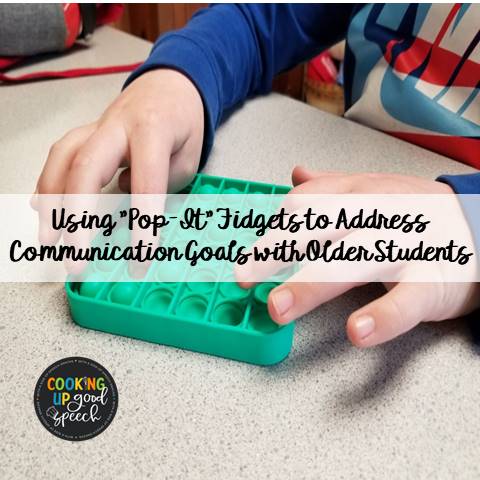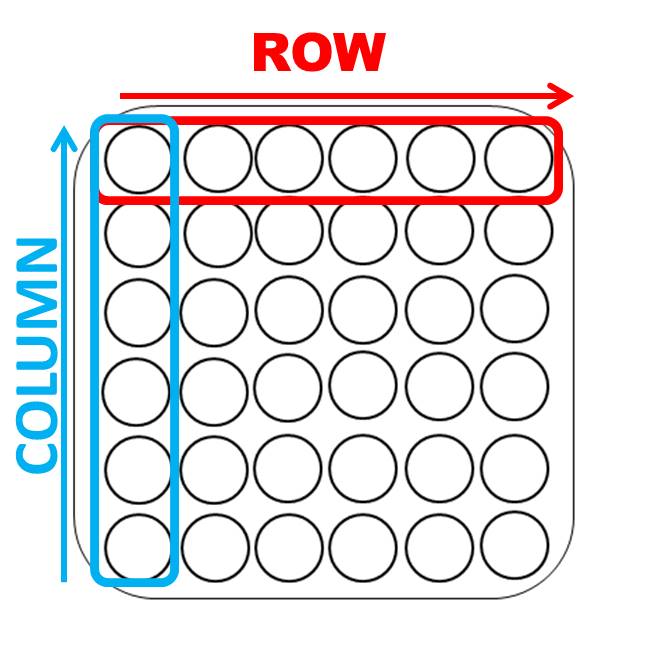
As educators, we already know the science behind the use of fidgets. They stimulate neural responses to produce an increase in blood circulation in the brain and extremities. It can ease the symptoms of generalized anxiety disorder, ADHD, obsessive-compulsive disorder, and autism. By now, many of us have discovered that one special fidget is more than just a good stress and anxiety reducer. Known as either “poppers”, “pop-it’s”, “bubble pops”, these fidgets can be used in our therapy sessions for a variety of engaging and effective purposes. If you’ve been using pop-it fidgets in your therapy sessions, you’ve probably received a positive reaction from your students. If you work with younger students, pop-its are a no-brainer, but did you know that your OLDER students also love these “toys”?! And by “older students” I don’t just mean your fifth graders—I mean your middle and high school kids too! In fact, if you want to get your older student’s attention, just put one of these magical objects in front of them and you will get an instant reaction when they walk into the room. Comments like “I saw these on Tik-Tok,” “Are we going to get to play with these?” “These are so satisfying,” are some of the responses I get when they spy my pop-it collection. I use pop-its as a therapy tool to address a multitude of communication goals as well as a reward after completing a speech/language activity, and as an “ice breaker” with new students. I discovered that when I add a pop-it to the mix it’s not so boring to work on multi-step direction following, conditional statements, temporal concepts, and auditory processing skills. I created a fun and engaging product that addresses these language goals—you can find it in my TpT store!
Pop-Its for Motivation and Engagement
When using pop-its as a motivational reward I have found success with the following activities:
1- Hidden Marble Game: You may have seen this idea floating around on social media. My kids love the suspense involved! I tell them that they can earn a round of play after completing a speech/language task(s). Hide a marble under one of the bubbles in the pop-it grid (don’t let your students see where you put the marble). Take turns popping one marble at a time, or better yet, roll the die and pop that number of bubbles. If you press down on the bubble that has the marble under it, you win the round! (OR you lose the round, depending on how you decide to play the game.)

2. 30-Second Challenge: Give each student a pop-it, a die, and set the timer on your phone for 30 seconds. When the timer starts, they roll their die and pop the number of bubbles that they roll. The student who pops the most bubbles at the end of the 30 seconds is the winner. You can adjust the timer depending on the size of the pop-it, or the age of your students. Just like in the hidden marble game, my students are very motivated to work on their communication goals when I tell them they can earn this game.

3- Last man standing-– This is a great game for your older students to play as a brain break, ice breaker, or motivator when you’re having a tough time getting them to engage. Plus, I love that there is strategy involved, which taps into your student’s executive functioning.
Play this game in pairs. Each pair will have a push bubble fidget toy. The first player pops down as many ‘bubbles’ as they want, though it must be in the same line. The next player goes and does the same thing, they can pop as many or as little as they like, but it must be within a line. The aim of the game is to NOT be the last player popping a bubble. You can check out this video on TikTok to see it in action (from @tipsfromatypicalmom.)
Pop-Its for Verbal Expression and Direction Following
Pop-It Barrier Game: Give each student a pop-it. Have one student explain which bubbles on the grid they want the other student(s) to pop. For example “Pop the first bubble in the first row and the last three bubbles in the fifth row.” This barrier game is will address direction following, listening skills, executive functioning, thought organization, and verbal expression. So much language is happening by all parties involved in this game! (My TpT activity has multi-step directions already planned out for you to use with a 6X6 pop-it grid.)
**Do your older students know the difference between ROWS and COLUMNS when giving and receiving directions?? These are good tier-2 vocabulary to review with them. See my visual below for reference:
Pop-Its for Conditional (If/Then) and Temporal (Before/After) Direction Following Skills
I created a TpT activity that addresses conditional and temporal skills. These are two areas that continue to challenge even many of my older students, especially those with weak auditory processing and comprehension. The pop-it fidget is a multi-sensory, interactive way of practicing these concepts. I ask my students to visualize the directions as they look at the pop-it grid and then repeat them back to me before attempting to carry out the steps. They are often very tempted to start popping away, (so I know they must be motivated and engaged) but first I have them apply the strategies that will create greater success (visualize, reauditorize, repeat), especially as the directions increase in length and complexity.
Here are a couple of examples of the if/then and before/after prompts that you will find in my TpT activity:
If today starts with the letter M, then pop the third bubble in the last row and all the bubbles in the first row.
Pop all the bubbles in the first row after you pop the last bubble in the second row.
Before you pop the second bubble in the second row, tell me your favorite color.
Pop-Its for Articulation Practice
Pop-It Puzzles: You’ve probably seen pop-its in a variety of fun sizes, shapes, and colors. Pop-it puzzles are one of my favorites! So much potential for so many activities! I found these in a gift shop while on vacation. You can also get them on Amazon. (And they’re in my Amazon store as well.)
1-The puzzle pieces can be given to each student in your group and put together once all students have successfully popped the bubbles in their puzzle pieces.
2-For articulation practice:
- Have each puzzle piece represent the beginning, middle and ending target sounds.
- Popping the bubbles can be an easy way (for the students) to collect data/track the number of repetitions/responses.
3-For mixed groups working on different speech /language goals, each puzzle piece can be used to help keep track of how many turns/opportunities have been given to each student in the group.
4-The puzzle pieces can provide opportunities for social collaboration/working as a team, problem-solving, and using executive functioning to create a plan. Give each student a piece of the puzzle. Have them connect the pieces together, and ask them to pop only the bubbles that will create a continuous connection from one piece to the next so that the only popped bubbles are the ones that connect the pieces together.

Pop-Its for Literacy Skills
I use pop-its to work on literacy skills. Many of my older students still require reinforcement to strengthen their literacy skills. Many of my students are dyslexic, so addressing phonemic awareness is a big part of my therapy repertoire.
Syllable Counting
Practice counting syllables in words. Dividing words into parts or “chunks” helps with the process of decoding.
Say the word, and each time you say a syllable, pop a bubble! (ex: cray-on, Sep-tem-ber)
Word Awareness
Words are the largest units of sounds so it is the easiest of all the phonological awareness skills. To practice this, say a sentence and have the student pop a bubble for every word. (ex: I like to eat tacos.) This activity of kinesthetic learning is helpful for children with phonological awareness weaknesses.
One more thing I like about this therapy tool–it’s easy to clean. Wash them, wipe them, spray them with a mild solution…whatever works best to get them cleaned quickly between sessions.
So many targets can be addressed with such a simple tool! What other ways do you use pop-its with your students?












Leave a Reply